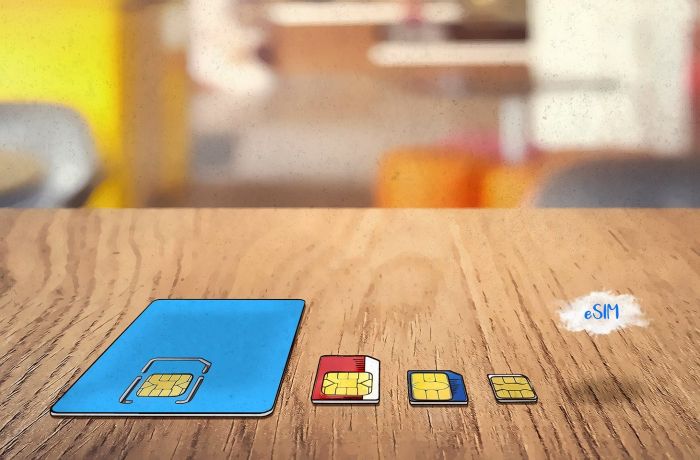Traditionally, a SIM card, or Subscriber Identity Module, has been a physical, removable chip inserted into a mobile device, serving as the authentication key that enables cellular connectivity. However, the eSIM embeds this functionality directly into the device’s hardware. Picture it as a virtual SIM securely integrated within a smartphone, smartwatch, or any compatible device, eliminating the need for a physical card.
Read More: Want To Stop Using X? Here’s How To Delete Or Deactivate Your Account
The Inner Workings of eSIM Technology
At its core, the eSIM operates similarly to a traditional SIM card. It stores essential information, such as the subscriber’s identity and network credentials, facilitating access to mobile networks. Yet, its virtual nature allows for flexibility. Users can switch between network carriers and plans without the hassle of physically swapping SIM cards. Instead, the process is simplified to a few taps on the device, granting instant access to a new network.
eSIM Advantages
Enhanced Physical Security: Since eSIMs are embedded within the device, they can’t be removed, lost, or stolen like physical SIM cards. This significantly reduces the risk of unauthorised access or tampering.
Authentication and Encryption: eSIMs employ robust authentication mechanisms, often exceeding those of traditional SIM cards. They utilise advanced encryption and authentication protocols, enhancing resistance to hacking attempts or unauthorised access.
Remote Management and Control: eSIMs enable remote provisioning and management, allowing for secure updates and activations without the need for physical interaction. This feature ensures that the network and security configurations remain up-to-date, reducing vulnerabilities.
Reduced Risk of Cloning or Fraud: Unique Identity and Protection Against Cloning: Each eSIM has a unique identifier, making it harder to clone compared to physical SIM cards. This uniqueness strengthens security measures, reducing the risk of identity theft or fraudulent activities.
Multi-Layered Security Features: eSIMs often come equipped with hardware-based security measures that bolster protection against various cyber threats. These measures include secure storage of sensitive information and the implementation of secure execution environments.
Secure User Authentication: eSIMs often include additional layers of user authentication and access control, reinforcing the security posture of the device and the network connections.
Continuous Security Updates: As technology evolves and new security threats emerge, eSIMs can receive firmware or software updates remotely, ensuring that security features stay current and resilient against emerging threats.
Read More: You can now delete your Threads profile without deleting your Instagram account
Reduced Physical Exposure: The embedded nature of eSIMs reduces the physical exposure of sensitive data, as they are not susceptible to being physically extracted or manipulated.
These collective enhancements create a more fortified ecosystem, reducing vulnerabilities and enhancing the overall safety of the user’s connectivity experience.
eSIM on AirtelTo begin, send an SMS with “eSIM your registered email address” to 121. If your email is valid, expect a confirmation message shortly from 121. Respond to this message by typing ‘1’. Following this, you’ll receive another SMS from 121, prompting consent via a call.
Once you’ve provided consent, anticipate a message from 121 containing the QR code sent to your registered email ID. Keep in mind that the entire activation procedure may take up to 2 hours with Airtel. If the activation hasn’t occurred within this timeframe, it’s advisable to reach out to customer support for assistance.
eSIM on Jio
Ensure your device compatibility with JIO eSIM by verifying through the official Jio Website.
Access Settings and navigate to About to locate and note down your IMEI and EID numbers.
From your Android device with an active JIO SIM, send an SMS with the text GETESIM <32 Digit EID> <15 Digit IMEI> to 199.
Upon completion, you’ll receive a 19-digit eSIM number and the configuration details of your eSIM profile.
Next, send another SMS, SIMCHG <19 Digit eSIM number> to 199.
Within 2 hours, an update on the eSIM processing will be provided. Once received, confirm it by replying with ‘1’ to 183.
Expect a call on your JIO number prompting you to share your 19-digit eSIM number.
Shortly after, you’ll receive a confirmation message, affirming the successful activation of your new eSIM.
eSIM on ViSend an SMS with “eSIM your registered email address” to 199. A confirmation message will follow promptly, validating your email accuracy.
Reply to this SMS with ESIMY to confirm your action. Subsequently, anticipate another SMS seeking consent via a call.
Once consent is granted, a message containing a QR code will be sent to your registered email ID.





































